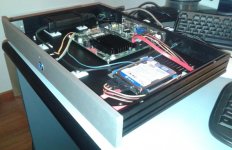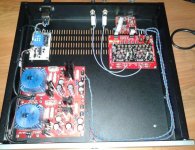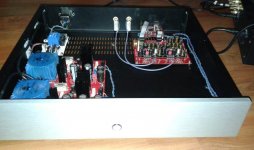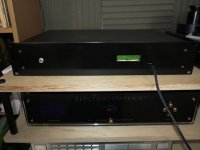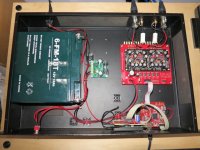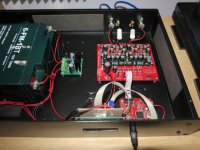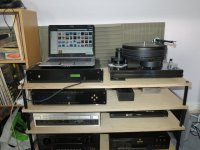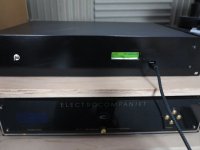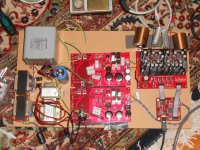My promised review between a one and 4 decks DAC. I had my onedeck dac and a good friend of mine had his 4 deck. We didn't do exotic modifications, but listen to it as it just is.
Both dacs use the Doede psu (2 for each dac) and the silver/gold/oil mundorfs.
Both dacs had its own macbook, and its own harddisk with the same music on it.
Further a very good tube preamplifier, a SE300B (Ceasar II) power amp, La Scala's 2005 speakers, coffee and later some white wine.
We started with Beethoven 3 symfonie the slow movement. By counting from 3 to 0 we started nearly eactly at the same time.....so switching from one to the other dac was easy listening.
First thing I noticed that the 4 decks dac didn't play much louder than the other (just a little bit..)
We heard a difference but it was first hard to describe what is was. We were listening to the same dac construction. And then it became clear. The 4 decks was even more analog, I can't describe it another way.
With both dacs I could live my life happy for ever after but....there was something in both dacs. The 1 deck was a bit more tight in the middle, the 4 deck dac seemed to be ......how to say....thinner...but it wasn't thinner....It was just a bit higher, and more transparent...
Then Berlioz cam, with Elly Ameling singing....she was standing there with 1 deck, and with the 4 there was even a bit more space around here, she seemed to became thinner, but it wasn't that, it was just that the little air around her seemed to ......mmmmm....difficult to describe very small differences without becoming to esoteric
Because D4 had a bit more air it seemed she became smaller, but with more presence.....
If you can still follow my experience..... Is it worth the money...mmmm as I said I can live with both dacs, and maybe I will change it deck by deck.....first I have to raise some funds for that....till then I am Enjoying my music....happy Eastern
Is it worth the money...mmmm as I said I can live with both dacs, and maybe I will change it deck by deck.....first I have to raise some funds for that....till then I am Enjoying my music....happy Eastern
Both dacs use the Doede psu (2 for each dac) and the silver/gold/oil mundorfs.
Both dacs had its own macbook, and its own harddisk with the same music on it.
Further a very good tube preamplifier, a SE300B (Ceasar II) power amp, La Scala's 2005 speakers, coffee and later some white wine.
We started with Beethoven 3 symfonie the slow movement. By counting from 3 to 0 we started nearly eactly at the same time.....so switching from one to the other dac was easy listening.
First thing I noticed that the 4 decks dac didn't play much louder than the other (just a little bit..)
We heard a difference but it was first hard to describe what is was. We were listening to the same dac construction. And then it became clear. The 4 decks was even more analog, I can't describe it another way.
With both dacs I could live my life happy for ever after but....there was something in both dacs. The 1 deck was a bit more tight in the middle, the 4 deck dac seemed to be ......how to say....thinner...but it wasn't thinner....It was just a bit higher, and more transparent...
Then Berlioz cam, with Elly Ameling singing....she was standing there with 1 deck, and with the 4 there was even a bit more space around here, she seemed to became thinner, but it wasn't that, it was just that the little air around her seemed to ......mmmmm....difficult to describe very small differences without becoming to esoteric
Because D4 had a bit more air it seemed she became smaller, but with more presence.....
If you can still follow my experience.....
Last edited:
Hi Jan,
I suspect you have compaired with the dac from (triode) Dick?
Nice review.
It makes me wonder what will be the best upgrade to do if you are on a budget and cannot do it all:
-go for more dac boards
-solder 4 tent shunt regulators on one dac board.
The shunt regulators make the sound much more dynamic and transparant, I suspect more so than with parallelling dac boards.
Only downside is you need some (de)soldering experience with the shunts.
Happy easter!
I suspect you have compaired with the dac from (triode) Dick?
Nice review.
It makes me wonder what will be the best upgrade to do if you are on a budget and cannot do it all:
-go for more dac boards
-solder 4 tent shunt regulators on one dac board.
The shunt regulators make the sound much more dynamic and transparant, I suspect more so than with parallelling dac boards.
Only downside is you need some (de)soldering experience with the shunts.
Happy easter!
Hey guys,
I just discovered that the Raspberry Pi has a i2s output. It takes an external clock. Does this mean that if I supply it with a high quality clock signal and drive it with the right software it will have minimal jitter, removing the need for an asynchronous reclocking circuit like the WaveIO has?
Granted ofcourse that I can get the software to reliably provide data for the i2s output.
I think maybe I can even get it to output the aligned format so even the mainboard is unnecessary?
Are there any errors in my line of thinking? I was wondering about it because the WaveIO is a lot more expensive than the Pi and the Pi has some other nice features (as it is a general purpose computer).
I just discovered that the Raspberry Pi has a i2s output. It takes an external clock. Does this mean that if I supply it with a high quality clock signal and drive it with the right software it will have minimal jitter, removing the need for an asynchronous reclocking circuit like the WaveIO has?
Granted ofcourse that I can get the software to reliably provide data for the i2s output.
I think maybe I can even get it to output the aligned format so even the mainboard is unnecessary?
Are there any errors in my line of thinking? I was wondering about it because the WaveIO is a lot more expensive than the Pi and the Pi has some other nice features (as it is a general purpose computer).
Hey guys,
I just discovered that the Raspberry Pi has a i2s output. It takes an external clock. Does this mean that if I supply it with a high quality clock signal and drive it with the right software it will have minimal jitter, removing the need for an asynchronous reclocking circuit like the WaveIO has?
Granted ofcourse that I can get the software to reliably provide data for the i2s output.
I think maybe I can even get it to output the aligned format so even the mainboard is unnecessary?
Are there any errors in my line of thinking? I was wondering about it because the WaveIO is a lot more expensive than the Pi and the Pi has some other nice features (as it is a general purpose computer).
Hi Tinco,
I have also thought about this. I disregarded the Pi because it suffers package loss when used with an USB receiver, this because both USB and ethernet are on the same buss system and that's not fast enough for hi-res streaming. You would not have this bottle-neck using the I2S out.
I also wonder how it would sound using the I2S on the GPIO pins, the advantage of waveIO is it's galvanic separation of the PC and DAC. There is a lot of noise on the PI ground connection that would pollute the signal. If you test the analog output you will understand what I mean.
You will also have to do some programming if you want to send the signal asynchronous to the DAC. All this is too much for me (I am not a programmer, I only like to heat a soldering iron now and then
I think however it must be possible and I hope you can figure it out. I for one am very interested in this idea!
Regards,
Hey Supersurfer,
I am a programmer, though I haven't done much in the way of driver development (it doesn't appeal to me ). Someone has already written an I2S driver, iterating on that if necessary should not be much of a problem.
). Someone has already written an I2S driver, iterating on that if necessary should not be much of a problem.
I wonder, if the clock signal is on a different power supply (and ground) than the Pi, wouldn't it be rather accurate? I am totally new to hardware, in my mind it would go like this: The cpu puts a value in the i2s buffer, which is put on the line when on the next clock tick.
If this is the way it works, the noise of the Pi has no effect on the quality of the signal as it is entirely driven by the external clock.
I have no idea if its even possible to have an external clock be on a different power supply, I'll have to read up on how that chip works.
Vrolijk pasen btw
(Happy Easters)
I am a programmer, though I haven't done much in the way of driver development (it doesn't appeal to me
I wonder, if the clock signal is on a different power supply (and ground) than the Pi, wouldn't it be rather accurate? I am totally new to hardware, in my mind it would go like this: The cpu puts a value in the i2s buffer, which is put on the line when on the next clock tick.
If this is the way it works, the noise of the Pi has no effect on the quality of the signal as it is entirely driven by the external clock.
I have no idea if its even possible to have an external clock be on a different power supply, I'll have to read up on how that chip works.
Vrolijk pasen btw
(Happy Easters)
Has anyone tried out different IV resistors. Would it be worth trying the Audio Note non magnetic type ?
yes, but with the bufallo dac and tube output...neoohm ww over texas components and an tant. best regards
Hey Supersurfer,
I am a programmer, though I haven't done much in the way of driver development (it doesn't appeal to me). Someone has already written an I2S driver, iterating on that if necessary should not be much of a problem.
I wonder, if the clock signal is on a different power supply (and ground) than the Pi, wouldn't it be rather accurate? I am totally new to hardware, in my mind it would go like this: The cpu puts a value in the i2s buffer, which is put on the line when on the next clock tick.
If this is the way it works, the noise of the Pi has no effect on the quality of the signal as it is entirely driven by the external clock.
I have no idea if its even possible to have an external clock be on a different power supply, I'll have to read up on how that chip works.
Vrolijk pasen btw
(Happy Easters)
Hallo Tinco,
The clock ground needs to be connected to the pc ground because the clock signal needs to be referenced to something. Also the I2S data signals will be referenced to the pc ground.
There is another way to overcome the ground pollution; put an isolator on the GPIO output signal, on the waveIO a GMR isolator (IL715 from NVE) is used for this purpose. However I expect the ground pollution will still raise jitter.
Groeten,
The idea is not bad and as it is generic ( every dac could work with this) you could make an own thread of it. lets stick here now on the DAC. I know how quickly we can get off topic 
To Jan, thanks for the comparison which is really apples with apples this time. normally you need to look back in your memory....
to super surfer, were the 8 volt shunts a special, or can you adjust them, what about the 5 volt which guido specs as minimum voltage for the regulator to work optimally, did you chek with him?
To Jan, thanks for the comparison which is really apples with apples this time. normally you need to look back in your memory....
to super surfer, were the 8 volt shunts a special, or can you adjust them, what about the 5 volt which guido specs as minimum voltage for the regulator to work optimally, did you chek with him?
to super surfer, were the 8 volt shunts a special, or can you adjust them, what about the 5 volt which guido specs as minimum voltage for the regulator to work optimally, did you chek with him?
Hi Doede,
The 8v is a special, tentlabs modifies the 15v version for this, together with the used current. The 8v works with your 12v supply, it has about 10,3v on the input of the shunt after local regulation on your board (Guido has confirmed this).
The 3,3v version is also adjusted by Guido to match the consumed current of the dac chip. The raw voltage here is higher than Guido states on his application note but this is OK because the current is low. I have soldered an extra drop resistor on the shunt but that should not be needed according to Guido.
the shunts can not be adjusted with a pot or so, you need to change resistors for this, and as the design is not published by tentlabs, they will do this for you.
After the sowters have burned in and the two extra dac boards are ready, I will fiddle around with the raw voltage settings to see if this makes an audible difference.
Regards,
The idea is not bad and as it is generic ( every dac could work with this) you could make an own thread of it. lets stick here now on the DAC. I know how quickly we can get off topic
Hey Doede, that's true, made a thread here: www.diyaudio.com/forums/digital-line-level/233230-raspberry-pi-i2s-output-asynchronous-usb-i2s.html
Finished (nearly) DDDAC
Hi All,
here are some photos of my DDDAC with LCD display showing the WaveIO status. Still sounding wonderful.
The WaveIO and Teensy/LCD are powered from a 7v wall socket SMPS via independent 5v regulators so room for improvement here. The drain on the lead acid was too great surprisingly. Perhaps my battery is not in top condition.
I am considering replacing the lead acid battery with lifepo4 ones. Has anyone any experience using these please ?
Regards.
Hi All,
here are some photos of my DDDAC with LCD display showing the WaveIO status. Still sounding wonderful.
The WaveIO and Teensy/LCD are powered from a 7v wall socket SMPS via independent 5v regulators so room for improvement here. The drain on the lead acid was too great surprisingly. Perhaps my battery is not in top condition.
I am considering replacing the lead acid battery with lifepo4 ones. Has anyone any experience using these please ?
Regards.
Attachments
Sound quality - single versus 4 deck
The first test was done with a motherboard with one deck only with Power supply as described earlier. Listening was via headphone (AKG 702) driven by Schiit Lyr headphone amp
In comparison to my other DAC ( Asus ) the difference was an improvement in the timing and tempo of music. There was some improvement in resolution, but the ASUS had a slightly greater weight.
4 Deck version - What a huge improvement! The lower end has greater weight and more importantly the resolution was just amazing. Listening to jazz ( Barbara Cartland at Birdland was the test disc), the piano sounded as if I was just a few feet from the instrument. Ambience retrieval in this live recording was just great. One of the aspects that demonstrates the resolving power is the fact that handclaps could be localised amongst the audience as well as the differences in how clapping sounds when different people are clapping. When listening to this CD with my CD player or through the ASUS,
I could guess the people were eating in the venue as I could make out the clink of cutlery. Through DDAC (4 deck) this resolved as the sound of a fork(?) being placed on a plate, the distinct sound we are familiar with at the dinner table.
An Appeal: Doede or anyone else, can you please advise if the 8 deck version improves on the 4 decks as significantly? I need to house this project; cant be done without deciding on the final configuration.
Lastly, am I glad that I chose this DAC. Now I can say that digital playback has a good standing to vinyl and open reel tape in my set up.
Cheers!
Ravi
The first test was done with a motherboard with one deck only with Power supply as described earlier. Listening was via headphone (AKG 702) driven by Schiit Lyr headphone amp
In comparison to my other DAC ( Asus ) the difference was an improvement in the timing and tempo of music. There was some improvement in resolution, but the ASUS had a slightly greater weight.
4 Deck version - What a huge improvement! The lower end has greater weight and more importantly the resolution was just amazing. Listening to jazz ( Barbara Cartland at Birdland was the test disc), the piano sounded as if I was just a few feet from the instrument. Ambience retrieval in this live recording was just great. One of the aspects that demonstrates the resolving power is the fact that handclaps could be localised amongst the audience as well as the differences in how clapping sounds when different people are clapping. When listening to this CD with my CD player or through the ASUS,
I could guess the people were eating in the venue as I could make out the clink of cutlery. Through DDAC (4 deck) this resolved as the sound of a fork(?) being placed on a plate, the distinct sound we are familiar with at the dinner table.
An Appeal: Doede or anyone else, can you please advise if the 8 deck version improves on the 4 decks as significantly? I need to house this project; cant be done without deciding on the final configuration.
Lastly, am I glad that I chose this DAC. Now I can say that digital playback has a good standing to vinyl and open reel tape in my set up.
Cheers!
Ravi
Hi All,
Photo of my test bench version described in post 229
Description of sound quality follows.
Cheers!
Cool
 choke loaded power supply! Have you compaired with the stock power supply design?
choke loaded power supply! Have you compaired with the stock power supply design?I recieved some Salas shunt supply boards today, will try them when the 4 dac boards and sowters are installed and burned in.
@tuyen: please report your findings if you try out the cap modification.
Regards,
Choke loaded supply
Hi Supersurfer,
I am a bit of a tube dinosaur. Hence went with choke loaded version to start with as I had the appropriate chokes in my bin.Hence no chance to compare power supplies. Other reasons for taking this path include minimising noise from rectification process which is difficult to get rid in subsequent stages. This is compounded with the high level of rfi noise in the environment these days.
If you do not mind the bulk and have access to chokes I would recommend taking this route.
Cheers!
Ravi
Hi Supersurfer,
I am a bit of a tube dinosaur. Hence went with choke loaded version to start with as I had the appropriate chokes in my bin.Hence no chance to compare power supplies. Other reasons for taking this path include minimising noise from rectification process which is difficult to get rid in subsequent stages. This is compounded with the high level of rfi noise in the environment these days.
If you do not mind the bulk and have access to chokes I would recommend taking this route.
Cheers!
Ravi
Hi Supersurfer,
I am a bit of a tube dinosaur. Hence went with choke loaded version to start with as I had the appropriate chokes in my bin.Hence no chance to compare power supplies. Other reasons for taking this path include minimising noise from rectification process which is difficult to get rid in subsequent stages. This is compounded with the high level of rfi noise in the environment these days.
If you do not mind the bulk and have access to chokes I would recommend taking this route.
Cheers!
Ravi
Hi Ravi,
I know from experience that chokes and the right tube rectifiers can make a lot of difference, I use 4 chokes a channell in my amps.
But my amps have unregulated supplys so I was wondering how much of the choke effect would penetrate through the power regulation.
I was wondering what the sound difference would be, if it makes a significant difference I would try it out.
I would certainly try some shottky diodes in the regulators........
Gerards,
- Home
- Source & Line
- Digital Line Level
- A NOS 192/24 DAC with the PCM1794 (and WaveIO USB input)
